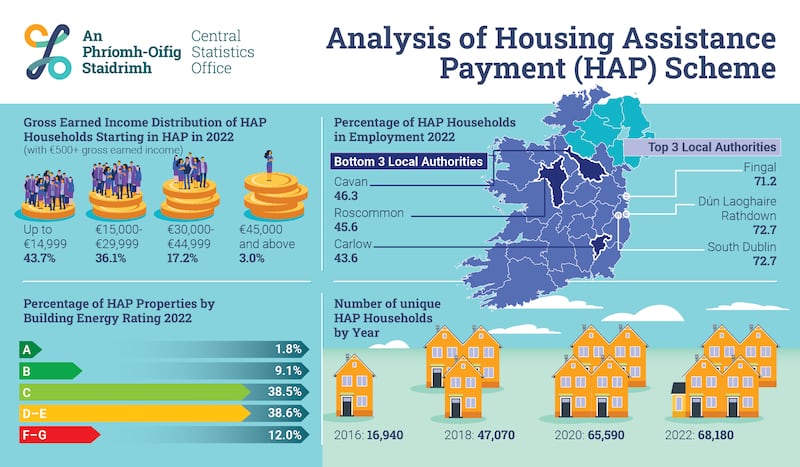The median income of working households dependent on the Housing Assistance Payment (HAP) last year was less than €20,000, with single parents with one child the most common household type to enter a HAP tenancy.
The latest HAP data from the Central Statistics Office (CSO) also shows the growing concentration of HAP properties in the ownership of large landlords and decreasing among smaller ones.
In its analysis of the HAP scheme for 2022 published on Friday , the CSO finds there were 68,180 “unique HAP households” – up from 65,590 in 2020. The local authority with the highest number was Dublin city (9,650), followed by Fingal (5,820), South Dublin (5,770), and Cork County (4,520).
The fewest households in HAP in 2022 were in Leitrim (380), Longford (410), and Cavan (530).
RTB tribunal orders tenant to vacate Galway property she was renting for almost 20 years
Nama chief is Government’s preferred option for ‘housing tsar’
House prices in Ireland continue to rise as shortage drives demand higher
South Dublin County Council seeks pass from itself for land deemed taxable on its own map
The HAP scheme was introduced in 2014, to be operated by local authorities, on a pilot basis in a small number of council areas before the national roll-out. It would largely replace rent supplement administered by the Department of Social Protection.
Unlike rent supplement, those in receipt can take up employment. Income thresholds for HAP vary from council to council and by household size. The local authority pays the monthly rent to the private landlord on behalf of the tenant, who in turn pays a differential rent based on household income to the local authority.

The CSO reports the median gross household earned income for working HAP households was €19,341 last year – up slightly from €18,867 in 2021. The highest incomes for HAP households were found in Dún Laoghaire (€25,039), Kildare (€24,407) and Cork City (€22,889), with the lowest in Donegal (€12,070), Mayo (€12,572) and Tipperary (€12,898).
Once placed in a HAP tenancy, the household is deemed “housed” and removed from the social housing waiting list, though they can apply to a “transfer list”.
Last year, the most common family type entering a HAP tenancy was ‘single, one child’, accounting for 25 per cent, with ‘couple’ being the least common, accounting for 4.7 per cent.
Around a quarter (24 per cent) of new HAP households were referred from homeless services – down from 32 per cent in 2021, but this had been increasing every year from 5.9 per cent in 2015.
The highest proportion of new HAP tenancies coming from homelessness was in South Dublin (48.9 per cent) and Dublin city (42.2 per cent), with the lowest in Donegal (6.3 per cent). Outside Dublin, the highest was in Waterford (32.1 per cent).
The proportion of HAP properties owned by landlords with 50 or more properties has increased every year from 1.3 per cent in 2015 to 19 per cent in 2022.
The increase in the number of HAP properties owned by these larger landlords is mirrored by a decrease in the proportion of landlords with just one or two properties, with this decreasing from close to three-quarters (74 per cent) in 2015 to just under a half (48.7 per cent) in 2022.
Commenting on the report, Justin Anderson, CSO statistician, said: “There has been a fall in the number of new households entering the HAP scheme since 2017, with 6,590 new entrants in 2022.
“More than half of tenants entering HAP in 2022 had been on the housing waiting list for less than a year before entry to the scheme. The housing waiting list also shows that more than 60 per cent of tenants coming to HAP in 2022 were from private rental accommodation.
“An increasing proportion of households entering HAP have some employment in the year they start, with this at 65 per cent in 2022, up from a low of 37 per cent in 2015.”
He added: “There has been an increasing number of exits from the HAP scheme over recent years, with 9,810 households leaving in 2022. Four in ten of those leaving in 2022 left to go to social housing. A further 25 per cent left due to the tenant ending the tenancy.
“While the median gross household earned income of tenants leaving HAP was €17,692 in the year they exit, this rises to €21,478 for those who can be identified as working three years after their year of exit.”












